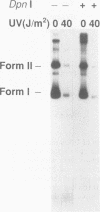Abstract
We have used in vitro DNA replication systems from human HeLa cells and monkey CV-1 cells to replicate a UV-damaged simian virus 40-based shuttle vector plasmid, pZ189. We found that replication of the plasmid was inhibited in a UV fluence-dependent manner, but even at UV fluences which caused damage to essentially all of the plasmid molecules some molecules became completely replicated. This replication was accompanied by an increase (up to 15-fold) in the frequency of mutations detected in the supF gene of the plasmid. These mutations were predominantly G:C-->A:T transitions similar to those observed in vivo. Treatment of the UV-irradiated plasmid DNA with Escherichia coli photolyase to reverse pyrimidine cyclobutane dimers (the predominant UV-induced photoproduct) before replication prevented the UV-induced inhibition of replication and reduced the frequency of mutations in supF to background levels. Therefore, the presence of pyrimidine cyclobutane dimers in the plasmid template appears to be responsible for both inhibition of replication and mutation induction. Further analysis of the replication of the UV-damaged plasmid revealed that closed circular replication products were sensitive to T4 endonuclease V (a pyrimidine cyclobutane dimer-specific endonuclease) and that this sensitivity was abolished by treatment of the replicated DNA with E. coli photolyase after replication but before T4 endonuclease treatment. These results demonstrate that these closed circular replication products contain pyrimidine cyclobutane dimers. Density labeling experiments revealed that the majority of plasmid DNA synthesized in vitro in the presence of bromodeoxyuridine triphosphate was hybrid density whether or not the plasmid was treated with UV radiation before replication; therefore, replication of UV-damaged templates appears to occur by the normal semiconservative mechanism. All of these data suggest that replication of UV-damaged templates occurs in vitro as it does in vivo and that this replication results in mutation fixation.
Full text
PDF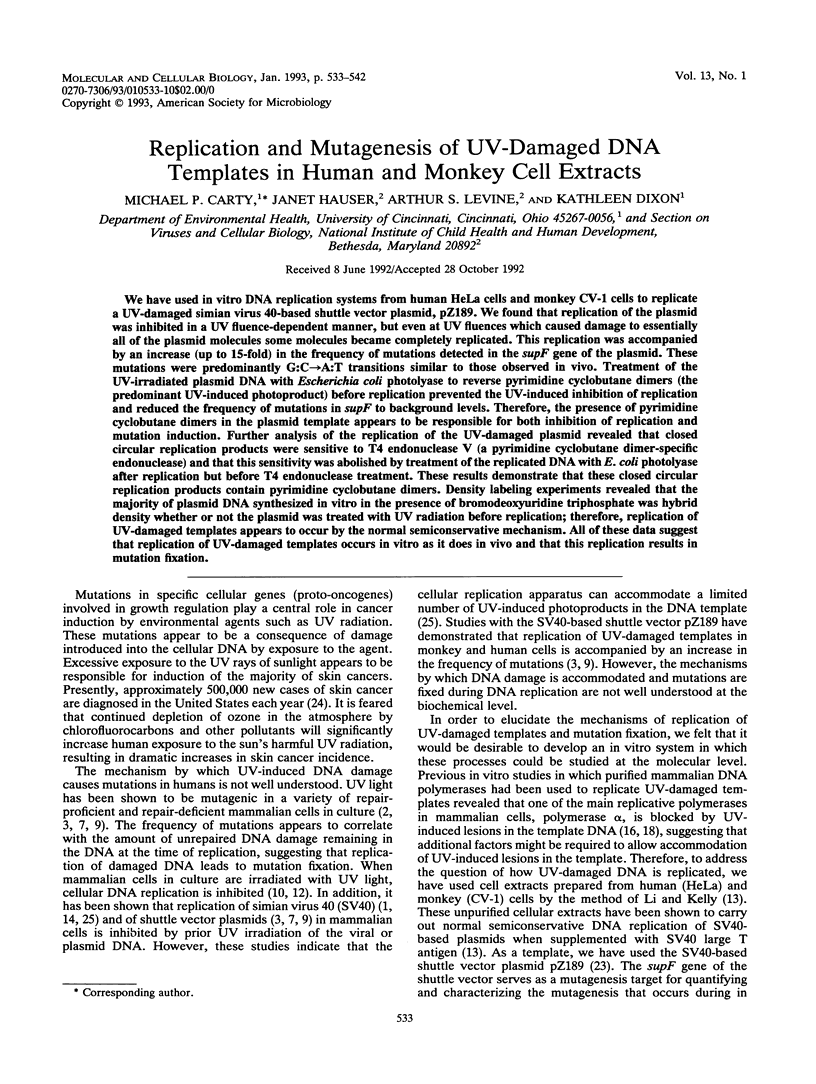
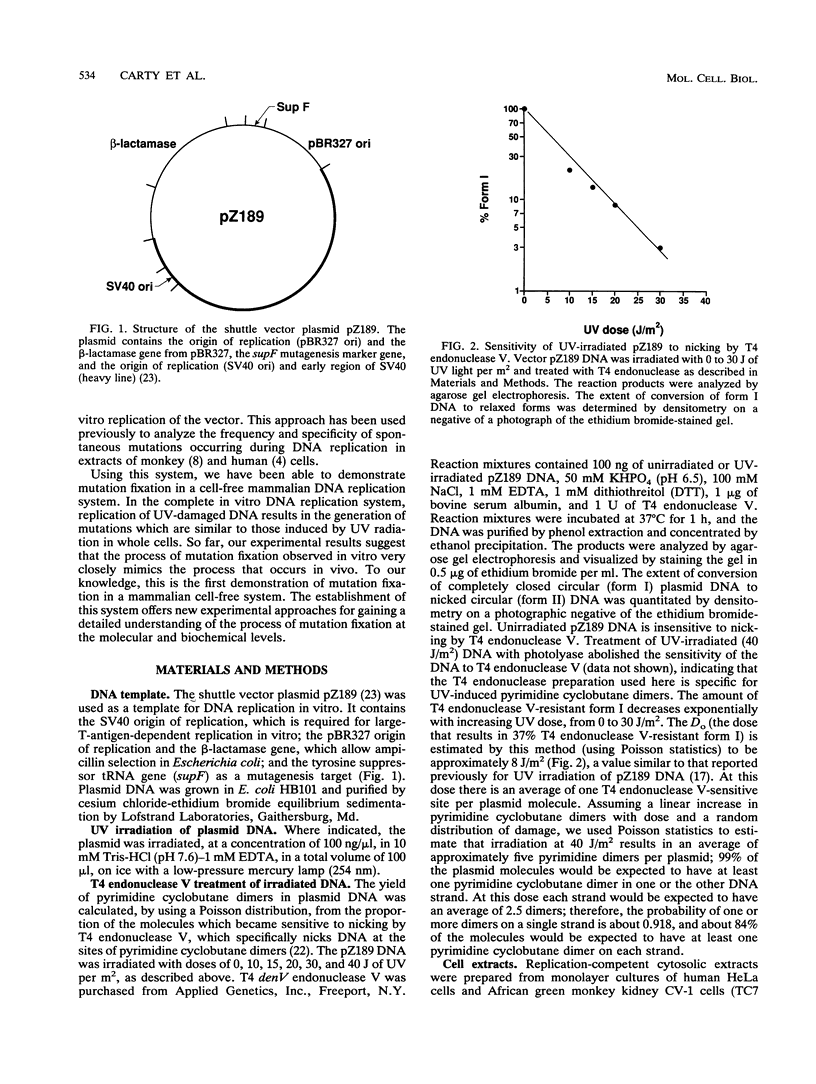

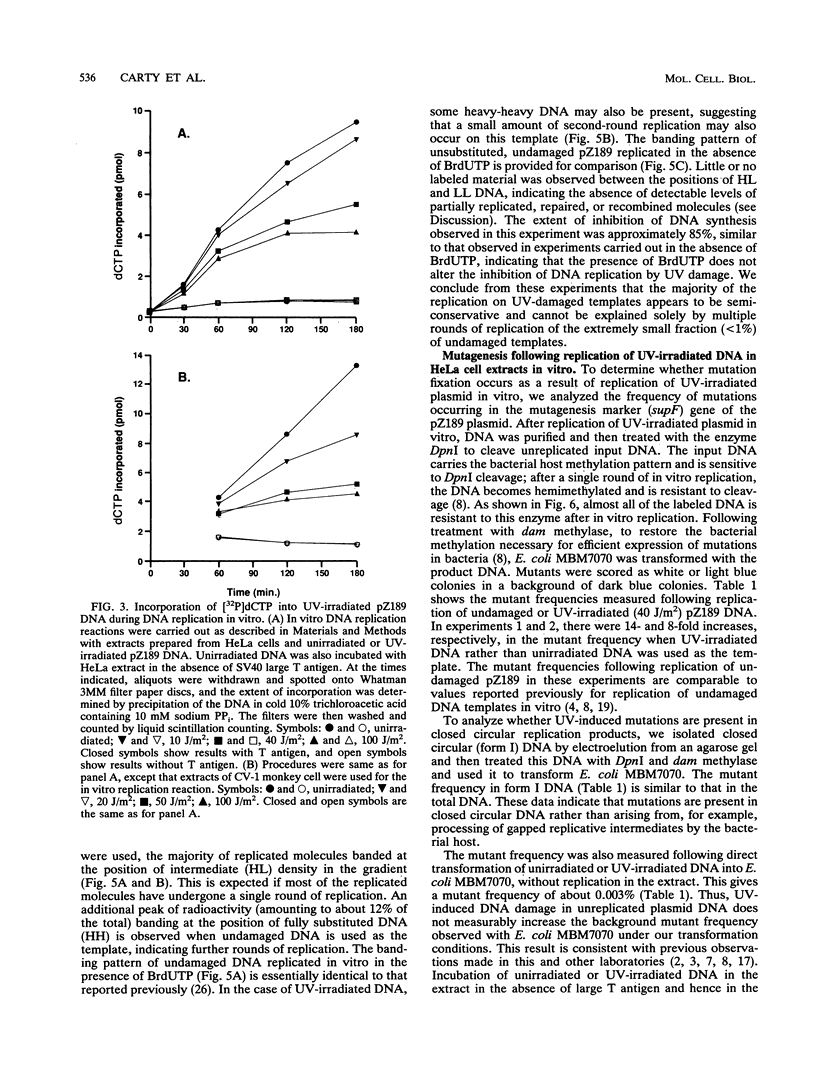
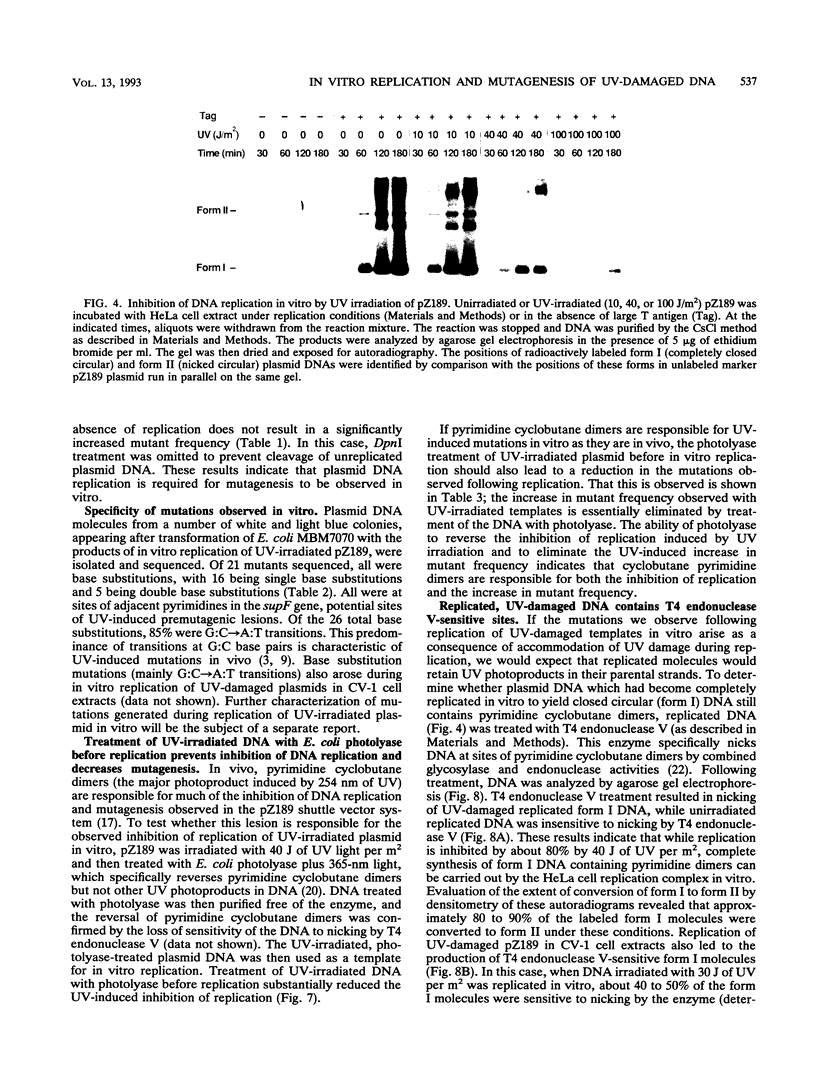
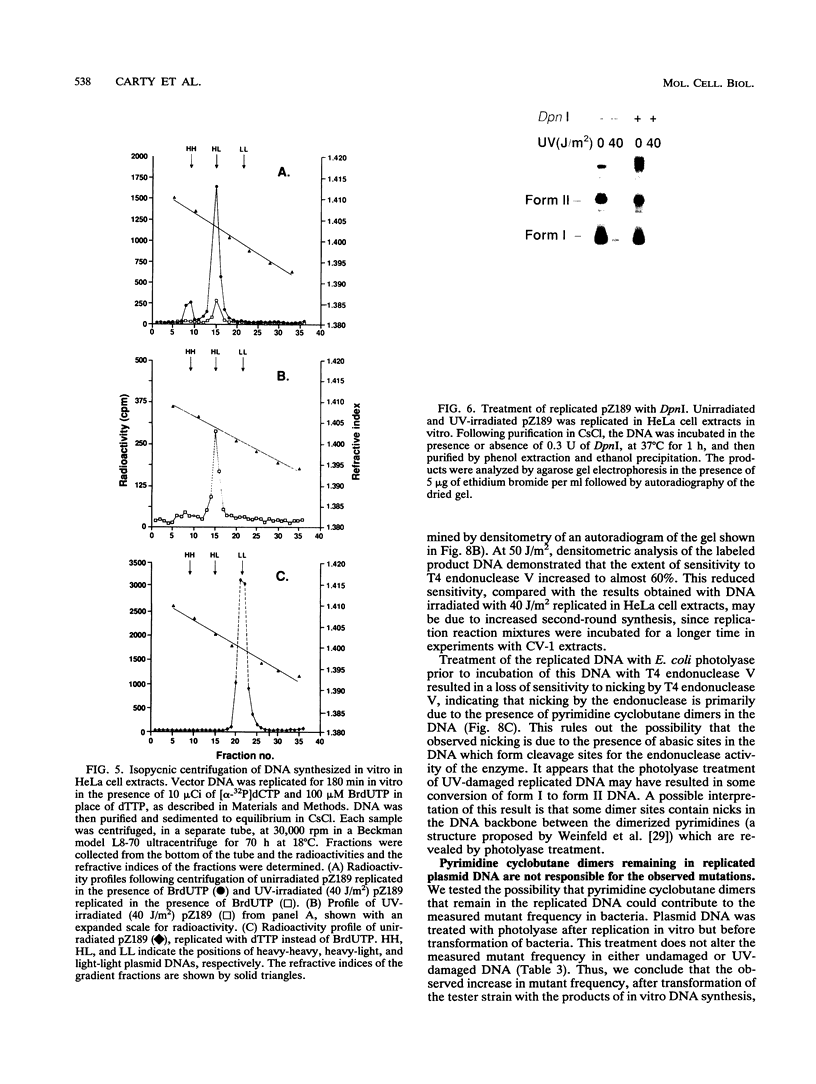
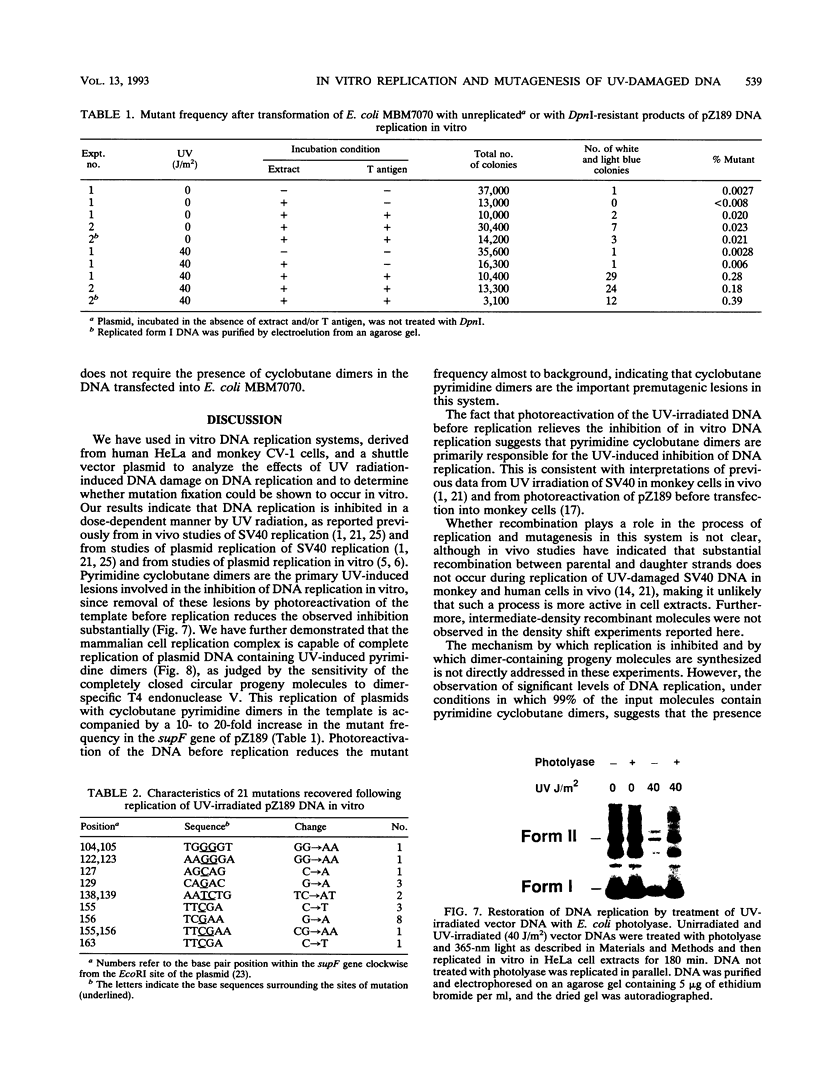



Images in this article
Selected References
These references are in PubMed. This may not be the complete list of references from this article.
- Berger C. A., Edenberg H. J. Pyrimidine dimers block simian virus 40 replication forks. Mol Cell Biol. 1986 Oct;6(10):3443–3450. doi: 10.1128/mcb.6.10.3443. [DOI] [PMC free article] [PubMed] [Google Scholar]
- Brash D. E., Seetharam S., Kraemer K. H., Seidman M. M., Bredberg A. Photoproduct frequency is not the major determinant of UV base substitution hot spots or cold spots in human cells. Proc Natl Acad Sci U S A. 1987 Jun;84(11):3782–3786. doi: 10.1073/pnas.84.11.3782. [DOI] [PMC free article] [PubMed] [Google Scholar]
- Bredberg A., Kraemer K. H., Seidman M. M. Restricted ultraviolet mutational spectrum in a shuttle vector propagated in xeroderma pigmentosum cells. Proc Natl Acad Sci U S A. 1986 Nov;83(21):8273–8277. doi: 10.1073/pnas.83.21.8273. [DOI] [PMC free article] [PubMed] [Google Scholar]
- Carty M. P., Ishimi Y., Levine A. S., Dixon K. DNA polymerase alpha from HeLa cells synthesizes DNA with high fidelity in a reconstituted replication system. Mutat Res. 1990 Oct;232(2):141–153. doi: 10.1016/0027-5107(90)90119-o. [DOI] [PubMed] [Google Scholar]
- Gough G., Wood R. D. Inhibition of in vitro SV40 DNA replication by ultraviolet light. Mutat Res. 1989 Nov;227(3):193–197. doi: 10.1016/0165-7992(89)90045-6. [DOI] [PubMed] [Google Scholar]
- Hauser J., Levine A. S., Dixon K. Fidelity of DNA synthesis in a mammalian in vitro replication system. Mol Cell Biol. 1988 Aug;8(8):3267–3271. doi: 10.1128/mcb.8.8.3267. [DOI] [PMC free article] [PubMed] [Google Scholar]
- Hauser J., Levine A. S., Dixon K. Unique pattern of point mutations arising after gene transfer into mammalian cells. EMBO J. 1987 Jan;6(1):63–67. doi: 10.1002/j.1460-2075.1987.tb04719.x. [DOI] [PMC free article] [PubMed] [Google Scholar]
- Hauser J., Seidman M. M., Sidur K., Dixon K. Sequence specificity of point mutations induced during passage of a UV-irradiated shuttle vector plasmid in monkey cells. Mol Cell Biol. 1986 Jan;6(1):277–285. doi: 10.1128/mcb.6.1.277. [DOI] [PMC free article] [PubMed] [Google Scholar]
- Kaufmann W. K., Cleaver J. E. Mechanisms of inhibition of DNA replication by ultraviolet light in normal human and xeroderma pigmentosum fibroblasts. J Mol Biol. 1981 Jun 25;149(2):171–187. doi: 10.1016/0022-2836(81)90297-7. [DOI] [PubMed] [Google Scholar]
- Lee S. H., Eki T., Hurwitz J. Synthesis of DNA containing the simian virus 40 origin of replication by the combined action of DNA polymerases alpha and delta. Proc Natl Acad Sci U S A. 1989 Oct;86(19):7361–7365. doi: 10.1073/pnas.86.19.7361. [DOI] [PMC free article] [PubMed] [Google Scholar]
- Lehmann A. R. Postreplication repair of DNA in ultraviolet-irradiated mammalian cells. J Mol Biol. 1972 May 28;66(3):319–337. doi: 10.1016/0022-2836(72)90418-4. [DOI] [PubMed] [Google Scholar]
- Li J. J., Kelly T. J. Simian virus 40 DNA replication in vitro. Proc Natl Acad Sci U S A. 1984 Nov;81(22):6973–6977. doi: 10.1073/pnas.81.22.6973. [DOI] [PMC free article] [PubMed] [Google Scholar]
- Mezzina M., Menck C. F., Courtin P., Sarasin A. Replication of simian virus 40 DNA after UV irradiation: evidence of growing fork blockage and single-stranded gaps in daughter strands. J Virol. 1988 Nov;62(11):4249–4258. doi: 10.1128/jvi.62.11.4249-4258.1988. [DOI] [PMC free article] [PubMed] [Google Scholar]
- Mitchell D. L., Nairn R. S. The biology of the (6-4) photoproduct. Photochem Photobiol. 1989 Jun;49(6):805–819. doi: 10.1111/j.1751-1097.1989.tb05578.x. [DOI] [PubMed] [Google Scholar]
- Moore P. D., Bose K. K., Rabkin S. D., Strauss B. S. Sites of termination of in vitro DNA synthesis on ultraviolet- and N-acetylaminofluorene-treated phi X174 templates by prokaryotic and eukaryotic DNA polymerases. Proc Natl Acad Sci U S A. 1981 Jan;78(1):110–114. doi: 10.1073/pnas.78.1.110. [DOI] [PMC free article] [PubMed] [Google Scholar]
- Protić-Sabljić M., Tuteja N., Munson P. J., Hauser J., Kraemer K. H., Dixon K. UV light-induced cyclobutane pyrimidine dimers are mutagenic in mammalian cells. Mol Cell Biol. 1986 Oct;6(10):3349–3356. doi: 10.1128/mcb.6.10.3349. [DOI] [PMC free article] [PubMed] [Google Scholar]
- Rabkin S. D., Moore P. D., Strauss B. S. In vitro bypass of UV-induced lesions by Escherichia coli DNA polymerase I: specificity of nucleotide incorporation. Proc Natl Acad Sci U S A. 1983 Mar;80(6):1541–1545. doi: 10.1073/pnas.80.6.1541. [DOI] [PMC free article] [PubMed] [Google Scholar]
- Roberts J. D., Kunkel T. A. Fidelity of a human cell DNA replication complex. Proc Natl Acad Sci U S A. 1988 Oct;85(19):7064–7068. doi: 10.1073/pnas.85.19.7064. [DOI] [PMC free article] [PubMed] [Google Scholar]
- Sancar A., Smith F. W., Sancar G. B. Purification of Escherichia coli DNA photolyase. J Biol Chem. 1984 May 10;259(9):6028–6032. [PubMed] [Google Scholar]
- Sarasin A. R., Hanawalt P. C. Replication of ultraviolet-irradiated simian virus 40 in monkey kidney cells. J Mol Biol. 1980 Apr;138(2):299–319. doi: 10.1016/0022-2836(80)90288-0. [DOI] [PubMed] [Google Scholar]
- Seidman M. M., Dixon K., Razzaque A., Zagursky R. J., Berman M. L. A shuttle vector plasmid for studying carcinogen-induced point mutations in mammalian cells. Gene. 1985;38(1-3):233–237. doi: 10.1016/0378-1119(85)90222-7. [DOI] [PubMed] [Google Scholar]
- Silverberg E., Lubera J. A. Cancer statistics, 1989. CA Cancer J Clin. 1989 Jan-Feb;39(1):3–20. doi: 10.3322/canjclin.39.1.3. [DOI] [PubMed] [Google Scholar]
- Stacks P. C., White J. H., Dixon K. Accommodation of pyrimidine dimers during replication of UV-damaged simian virus 40 DNA. Mol Cell Biol. 1983 Aug;3(8):1403–1411. doi: 10.1128/mcb.3.8.1403. [DOI] [PMC free article] [PubMed] [Google Scholar]
- Stillman B. W., Gluzman Y. Replication and supercoiling of simian virus 40 DNA in cell extracts from human cells. Mol Cell Biol. 1985 Aug;5(8):2051–2060. doi: 10.1128/mcb.5.8.2051. [DOI] [PMC free article] [PubMed] [Google Scholar]
- Tsurimoto T., Melendy T., Stillman B. Sequential initiation of lagging and leading strand synthesis by two different polymerase complexes at the SV40 DNA replication origin. Nature. 1990 Aug 9;346(6284):534–539. doi: 10.1038/346534a0. [DOI] [PubMed] [Google Scholar]
- Walker G. C. Mutagenesis and inducible responses to deoxyribonucleic acid damage in Escherichia coli. Microbiol Rev. 1984 Mar;48(1):60–93. doi: 10.1128/mr.48.1.60-93.1984. [DOI] [PMC free article] [PubMed] [Google Scholar]
- Weinfeld M., Gentner N. E., Johnson L. D., Paterson M. C. Photoreversal-dependent release of thymidine and thymidine monophosphate from pyrimidine dimer-containing DNA excision fragments isolated from ultraviolet-damaged human fibroblasts. Biochemistry. 1986 May 6;25(9):2656–2664. doi: 10.1021/bi00357a055. [DOI] [PubMed] [Google Scholar]
- White J. H., Dixon K. Gap filling and not replication fork progression is the rate-limiting step in the replication of UV-damaged simian virus 40 DNA. Mol Cell Biol. 1984 Jul;4(7):1286–1292. doi: 10.1128/mcb.4.7.1286. [DOI] [PMC free article] [PubMed] [Google Scholar]




